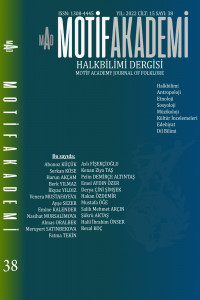SÖZLÜ ŞİİRDEN AYTISA: KAZAK FOLKLORUNDAKİ BÄDİK ŞİİRLERİNİN TÜRSEL DEĞİŞİMİ
FROM ORAL POETRY TO AYTIS: THE SPECIES CHANGE OF BADIK POEMS IN KAZAKH FOLKLORE
Author(s): Meruyert SatinbekovaSubject(s): Museology & Heritage Studies, Customs / Folklore, Oral history, Other Language Literature, Theory of Literature
Published by: Motif Halk Oyunları Eğitim ve Öğretim Vakfı
Keywords: Oral poetry; oral culture; badikpoems; badik aytis; the art of deyishme;
Summary/Abstract: One of the oldest folklore legacies of the Turkic peoples of Turkestan is the poems called bädik. Examples of badik poems are most often found in the folklore of the Kazakhs, Kyrgyzs, Karakalpaks, Uzbeks. This shows that the formation of badik poems extends deep into history and is a common cultural heritage of the Turkic World. It has been believed that every disease has a cause of occurrence in the ancient Turkestan lands bearing the traces of the kam or baksi tradition. Until the beginning of the XX century, in the geography of Turkestan there was a tradition to heal sick pets by singing badik poetry. The badik poems, which were composed among the Kazakhs, later underwent a change in structure and function, and turned into badik aytis, which girls and boys gather and recite. Thus, the purpose of such deyishme has ceased to be to heal sick animals, and has turned into ensuring that young people have fun by talking to each other. In various books on Kazakh folklore and literary history, the concepts of “badik poetry” and “badik aytis” have been used until this day. "Badik poetry" has been included in some books as traditional poems. In some sources, it is recorded as “badik aytis”. In this article, the function of badik poems in Kazakh folklore and the ways of their conversion into aitis are considered and evaluated from a historical point of view. After the evaluation, it was concluded that the badik aytis, which influenced the beginning of the aytis genre to a certain extent, was considered as a different aytis type and that it was wrong to evaluate with the dimensions of the modern aytis.
Journal: Motif Akademi Halkbilimi Dergisi
- Issue Year: 15/2022
- Issue No: 38
- Page Range: 458-468
- Page Count: 11
- Language: Turkish

